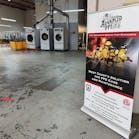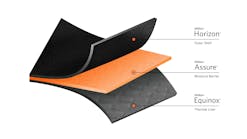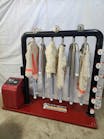PPE: Clean, Maintain & Store
The fire service has become extremely health conscious—and rightly so. Proper cleaning, maintenance and storage of protective clothing are essential to improving firefighter health and safety. However, there are some misconceptions about PPE that could hamper a firefighter’s ability to take a health-focused approach to these topics. With that in mind, let’s dispel a few myths with facts.
Myth: If I launder my gear too frequently, it will lose some of its flame resistance.
Fact: The special fabrics that make up your three-layer turnout system, regardless of manufacturer, will NOT lose heat or flame resistance regardless of how many times they are laundered. These characteristics are inherent to the base fibers, meaning they cannot be washed out or dissipate with use.
Myth: Dirty gear is the sign of a seasoned veteran.
Fact: Dirty gear is the sign of an uneducated firefighter. The truth is that the byproducts of combustion are combustible. Even with the inherent characteristics, flame and heat resistance can be compromised if the garment is worn in an extremely soiled condition. For example, a fiber such as polybenzimidazole (PBI) will not normally ignite unless in the presence of a super oxygen-enriched environment. However, if a PBI fabric was dipped in diesel fuel and then subjected to flame, the fuel would burn until there was nothing left, resulting in the PBI shell fabric becoming totally consumed. Additionally, firefighters are subjected to many different chemicals and contaminants, all of which can be absorbed into the protective gear and many of which are hazardous to the firefighters’ health. Advanced cleaning of protective gear is imperative to protecting the firefighter.
Myth: Where I store my gear is more important than how I store my gear.
Fact: Where you store your gear and how your store your gear are equally important factors. Gear that is stored wet, or is stored where moisture is present, can develop mold and other fungi. Additionally, storing soiled gear will cause impurities to become more deeply imbedded into the fabric fibers. If you are storing soiled gear, you are also storing all of the contaminants that may be present in that gear.
Myth: As long as I rinse my gear after every exposure, there is no need to launder further.
Fact: While rinsing at the scene is very effective in removing surface soil and debris, it does not take the place of an advanced cleaning. NFPA 1851 breaks cleaning down to two levels: routine and advanced. Routine cleaning is done by the wearer at the scene and does not use or require any mechanical action. Advanced cleaning is always done with a mechanical action (i.e., extractor) and is required to be done at least once a year as a minimum or whenever a routine cleaning is obviously insufficient to remove dirt and grime. Rinsing with cold water (routine cleaning) is simply not sufficient enough to remove all of the contaminants to which firefighters are regularly exposed.
Myth: Small tears, burns or cuts in my protective gear can be ignored as long as they are just minor.
Fact: A breach in any layer of the protective clothing must be addressed immediately. Smoke, chemicals, heat and other hazards of firefighting can enter through any rupture in the protective envelope, regardless of how seemingly insignificant.
Myth: My backup gear is not as important as my primary set, as it is only used if my principal gear is for some reason unavailable.
Fact: Your “backup” gear becomes your front line gear the moment you don it, and it must be treated with the exact same care and maintenance as your primary set of gear. Any protective gear should be considered as your primary protection.
Dispel the myths
So how do we dispel the myths and care for protective clothing? The following requirements are per NFPA 1851: Standard on Selection, Care and Maintenance of Protective Ensembles for Structural Fire Fighting and Proximity Fire Fighting, 2014 Edition. Note: This standard is quite a comprehensive user document, and all fire personnel should read it to get a fuller picture of PPE cleaning, maintenance and storage.
The proper way to perform advanced cleaning (mechanical washing):
- Front-loading washing machines (aka extractors) are preferable.
- Do not overload the machine.
- Pre-treat heavily soiled or spotted areas.
- Separate outer shells from liners, remove drag rescue devices and suspenders, and wash independently.
- Turn the liner system inside out.
- All closures (zippers, hook and D-rings, plush and loop) must be fastened prior to laundering.
- Water temperature should not exceed 105 degrees F.
- Use mild detergent (pH factor of 6.0 to 10.5), as indicated on safety data sheet or product container.
- Adjust the washing machine so that the g-force does not exceed 100 g (follow machine manufacturer instructions for proper setting or program selection).
- Inspect after cleaning and rewash if necessary.
- Dry in an area with good ventilation; do NOT dry in direct sunlight.
- Ensure that all closures are fastened prior to drying.
- If machine drying, do not overload capacity of machine; use “no heat” or “air dry only” option.
- If machine drying, basket temperature should not exceed 105 degrees F.
The proper way to store gear:
- Store in a clean, dry, well-ventilated setting.
- Store away from direct sunlight or any UV-producing lights.
- Do not store in temperatures above 180 degrees F or below -25 degrees F.
- Do not store in vehicle trunks, unless protected by a gear bag or other covering.
- Do not store in airtight containers, unless new and unused.
- Do not store in contact with oils, solvent, acids, alkalis or other contaminants.
- Do not store in personal lockers or living quarters.
The proper way to maintain your gear:
- Gear should be routinely inspected after each use, by the wearer, looking for any signs of damage. If any type of damage, discoloration or degradation is present, the garment should be forwarded to the safety officer or other authority having jurisdiction for further assessment.
- NFPA 1851 requires any field repairs to be performed by the original manufacturer, a verified independent service provider (ISP), or a member of the department who has had the required level of training.
- All repairs shall be done in like manner as manufacturer using NFPA-compliant materials.
- Basic repairs shall be limited to the following: patching of minor tears, char marks and ember burns; repairing of skipped, broken and missing stitches; replacement of missing hardware, excluding hardware that is part of positive closure system; reclosing of the liner of a garment after complete liner inspection.
- When performing repairs, remove the liner system from the outer shell to avoid accidental damage.
- Repairs must be made to all layers of the garment that have been damaged. If there is a tear or burn in the outer shell, check the thermal liner and moisture barrier to make sure these layers were not affected.
- Patches shall be limited to 32 cm2 (5 in2). The finished edges of a patch shall extend at least 1 inch in all directions beyond the damaged area, with no raw edges on the patch to prevent fraying. Patches should be large enough to allow for turning under all edges at least a half-inch on each side.
- Where installing a patch to the outer shell, it is recommended that the interior of the fabric be patched as well to prevent further damage from washing and general wear.
- If replacing trim or covering trim with an option, any covered trim must be replaced. Trim patches must not exceed 3 inches in length and must extend 1 inch beyond the damaged area, with a maximum of 2 patches per trim stripe allowed.
- Re-stitching more than 1 inch of an outer shell Major A seam, or a thermal liner Major B seam, requires consulting the manufacturer.
- Repairs to moisture barrier seams require consulting the manufacturer.
- Manufacturer should always be consulted if unsure of the complexity of the repair.
In sum
PPE is a critical line of defense against the dangerous environment in which you perform your duties. Keeping your gear clean, well maintained and properly stored, contributes to your health and safety.
Sidebar: Educating Customers about PPE
“How do you make sure that the gear is well maintained and cleaned properly? That involves educating each individual end-user. It’s not just a department question anymore; it means the user needs to understand the limitations of their gear and how to keep it so it will continue to protect them for a long time to come. That educational process is ongoing and continuous—it’s a big deal that we take very seriously
In terms of the gear itself, because of the amount of carcinogens and the impact on firefighters, there’s much more understanding that dirty gear is not a badge of honor; it is dangerous. Firefighters need to take appropriate action after every exposure with their gear, whether that’s some kind of field decontamination or being able to put it through an extractor, depending on what the exposure is. Some of that is a cultural issue that’s starting to gain some traction. People are understanding that’s not how you want to look; that’s how you want to avoid looking as you move forward. And the firefighter can’t contribute to the problem by continuing to wear gear that is dirty and contaminated. That’s easier said than done. It requires two sets of gear in a busy department. It also means that they have to have a process where gear can be cleaned regularly and frequently, and there’s a consequence to doing that.
Turnout gear doesn’t last forever; no protective product does. But when you think that it’s often worn every day for hours at a time, for years, it’s got a tremendous service lifetime, even if that lifetime isn’t forever. And the more it’s exposed to everything—chemicals, sunlight, fluorescent light, contaminants, washing—all of those degrade the product. So it’s not realistic to think that if you washed it every day that it was going to stand up and last as long. But if you’re getting involved in serious exposures, you need to make sure that those are addressed and that the gear remains clean or else the sacrifice isn’t to the gear anymore; it’s to your health and the health of the other firefighters on your team.”
— Mark Mordecai, director of business development, Globe
Patricia Freeman
Patricia Freeman is the technical services manager for Globe Manufacturing Company.






